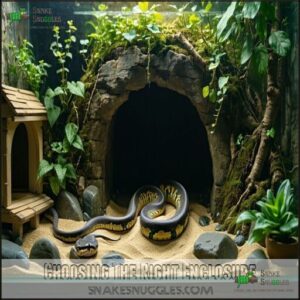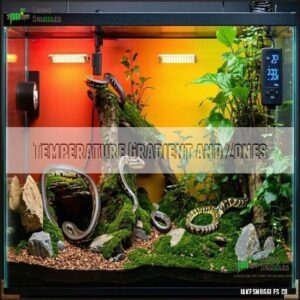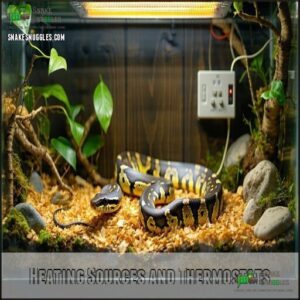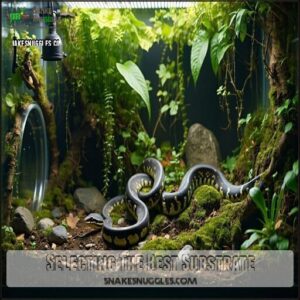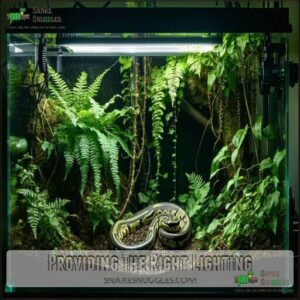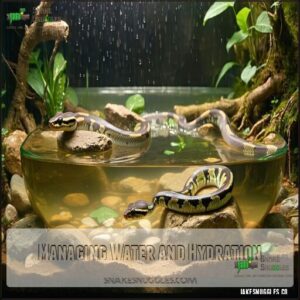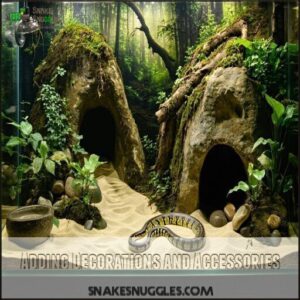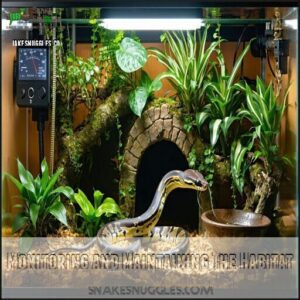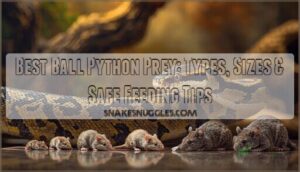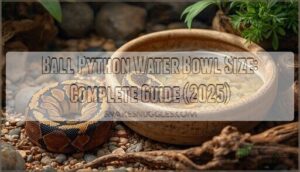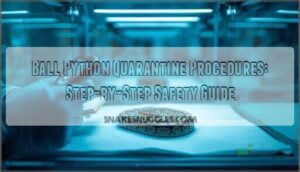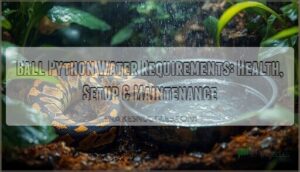This site is supported by our readers. We may earn a commission, at no cost to you, if you purchase through links.
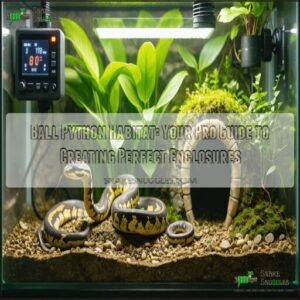
Maintain a warm basking spot around 88-92°F and a cooler side near 78-80°F, using under-tank heating pads and digital thermometers. Keep humidity between 50-60% using substrate like coconut fiber or cypress mulch, and provide a humidity box for shedding.
Include at least two hiding spots – one on the warm side, another on the cool side – using cork bark, half logs, or commercial snake caves. Strategic placement mimics their natural woodland environment, helping your slithery friend feel secure and comfortable in their natural space.
Table Of Contents
- Key Takeaways
- Choosing The Right Enclosure
- Setting Up The Right Temperature
- Maintaining Proper Humidity
- Selecting The Best Substrate
- Providing The Right Lighting
- Creating Hiding Spots and Visual Barriers
- Managing Water and Hydration
- Adding Decorations and Accessories
- Monitoring and Maintaining The Habitat
- Frequently Asked Questions (FAQs)
- How to set up a ball python’s habitat?
- How to set up ball python enclosures?
- How do you set up a ball python home?
- How do I set up a ball python terrarium?
- What is needed for a ball python habitat?
- What is the best enclosure setup for a ball python?
- Can you leave a heat lamp on 24/7 for ball python?
- How Often Should I Clean My Ball Python’s Enclosure?
- What is the Best Way to Feed My Ball Python?
- How Often Should I Handle My Ball Python?
- Conclusion
Key Takeaways
- You’ll need to create a precise thermal gradient in your ball python’s habitat, maintaining temperatures between 75-95°F with warm and cool zones that allow your snake to thermoregulate naturally.
- Your enclosure must mimic the ball python’s natural environment by providing multiple hiding spots, using appropriate substrate like cypress mulch, and maintaining 50-60% humidity to support your snake’s health and comfort.
- You’ll want to invest in reliable monitoring tools like digital thermometers and hygrometers to track temperature and humidity levels, ensuring a consistent and stress-free living space for your ball python.
- You’ll need to establish a regular cleaning and maintenance routine, with daily spot cleaning, weekly water dish sanitization, and monthly deep cleaning to prevent bacterial growth and maintain a healthy habitat.
Choosing The Right Enclosure
When creating the perfect habitat for your ball python, you’ll want to choose an enclosure that mimics their natural environment while providing comfort and security.
Your goal is to select a spacious, well-ventilated enclosure that offers enough room for your snake to move, hide, and thermoregulate effectively.
Enclosure Size and Type
When setting up your ball python’s home, size matters—and bigger is definitely better! Choose an enclosure that gives your slithery friend room to roam.
- Minimum 4’L x 2’W x 2’H for adult pythons
- Consider material versatility (glass, plastic, custom wood)
- Prioritize proper ventilation and habitat enrichment
Glass tanks offer killer visibility, while plastic setups save your wallet.
Pro tip: customize your python’s pad with strategic décor and airflow to create a comfortable, stress-free reptile retreat that mimics their natural environment.
Enclosure Height and Depth
Your ball python’s kingdom needs more than just floor space—it craves vertical adventure!
With enclosure height ranging from 12–24 inches, you’ll create a habitat that lets your scaled friend explore and feel secure.
Substrate depth matters too, with a minimum 3-inch layer mimicking natural terrain.
| Enclosure Aspect | Snake Happiness |
|---|---|
| Height Options | Climbing Zones |
| Depth Needs | Burrowing Comfort |
| Spatial Layout | Security Heaven |
Setting Up The Right Temperature
You’ll want to master the temperature game to keep your ball python happy and healthy in its new home.
Creating the right thermal gradient isn’t rocket science—it’s about providing warm and cool zones that’ll make your scaly friend feel just like it’s back in its natural West African habitat.
Temperature Gradient and Zones
Like a perfectly designed home with different climate zones, your ball python’s enclosure needs strategic thermal gradients to keep them healthy and comfortable.
Your snake will naturally regulate its body temperature by moving between warm and cool areas.
- Create a thermal landscape with temperatures ranging from 75–80°F on the cool side to 88–92°F on the warm side
- Strategic placement of heat sources allows your python to choose its ideal comfort zone
Reliable thermometers are vital for monitoring these temperature variations. Consistent temperature control supports your snake’s well-being, preventing stress and supporting precise physiological functions through precise thermoregulation. A proper Ball Python Heater setup is essential for maintaining the ideal temperature range, using a heater control system.
Heating Sources and Thermostats
Mastering your ball python’s warmth means choosing the right heating arsenal.
Keep your scaly friend toasty with smart temperature control techniques that prevent overheating and guarantee comfort.
- Protect your python’s health with precise thermostat settings
- Prevent potential temperature-related stress
- Create a safe, regulated habitat
- Maintain consistent reptilian wellness
Heat mats, ceramic heaters, and heat lamps become your precision tools.
An undertank heat mat paired with a reliable thermostat transforms your enclosure into a reptilian paradise, giving your python the warm embrace it craves, ensuring a safe and regulated environment.
Maintaining Proper Humidity
You’ll need to master humidity control to keep your ball python thriving in captivity, as these sensitive reptiles demand precise moisture levels for peak health.
By understanding how to maintain the right humidity range and using strategic techniques like misting and humidity chambers, you’ll create a comfortable environment that mimics their natural West African habitat.
Humidity Levels and Ranges
Because proper humidity control can make or break your ball python’s health, you’ll want to nail those moisture levels precisely.
Your reptilian friend thrives in a delicate balance of air quality and hydration. Here’s how to master humidity:
- Track levels religiously with a reliable hygrometer
- Aim for 50-60% humidity consistently
- Monitor environmental changes that impact moisture
- Adjust substrate to optimize water content
Low humidity creates shedding nightmares, while excessive moisture invites respiratory complications.
Your vigilance guarantees a comfortable, healthy habitat.
Humidifiers and Misting Systems
A humidity-control arsenal can transform your ball python’s habitat from dry to just right.
Water sprayers and foggers become your secret weapons in maintaining ideal moisture levels.
Use a misting system with a precise timer to create consistent 55-60% humidity zones.
Hygrometers are your trusty sidekicks, helping you monitor these delicate environmental changes.
During shedding periods, a quick humidity chamber boost can make all the difference.
Pro tip: Clean water and regular checks keep your snake’s environment healthy and comfortable.
Maintaining essential humidity levels is vital for your snake’s overall health and well-being.
Selecting The Best Substrate
When creating the perfect ball python habitat, you’ll want to choose a substrate that mimics their natural environment and supports their health and comfort.
Your substrate selection isn’t just about looks—it’s a critical component that helps regulate humidity, provides enrichment, and helps guarantee your snake feels secure in its new home, which is crucial for their overall health.
Popular Substrate Options
After managing humidity, you’ll want to nail your substrate selection. Not all bedding is created equal for your slithery friend! Your ball python needs a comfy, moisture-rich home that mimics natural environments.
- Cypress mulch offers tropical vibes and excellent moisture retention
- Coconut fiber creates a naturalistic base that locks in humidity
- Aspen shavings provide a clean, burrowing-friendly surface
Different substrates serve different snake needs—choose wisely to keep your scaled companion happy and healthy! Considering the importance of bioactive substrate options is vital for creating a thriving environment.
Substrate Maintenance and Cleaning
A pristine substrate is the backbone of a healthy ball python habitat. Your cleaning routine matters more than you might think.
Daily spot cleaning prevents waste accumulation, while strategic substrate maintenance guarantees ideal living conditions. Choosing the right Ball Python Substrate is vital for the health of your pet.
| Substrate Type | Spot Cleaning Frequency | Full Replacement |
|---|---|---|
| Aspen Bedding | Daily | Monthly |
| Cypress Mulch | Every 2-3 days | Monthly |
| Coconut Husk | Weekly | Every 4-6 weeks |
Use precision tools like small scoops or tongs, monitoring substrate depth to maintain ideal moisture control and humidity levels. Consistent cleaning keeps your snake’s environment safe and comfortable.
Providing The Right Lighting
You’ll be surprised to learn that ball pythons don’t need specialized lighting, but they do require a consistent day-night cycle that mimics their natural habitat.
By understanding their light requirements and avoiding direct sunlight, you’ll create a comfortable and stress-free environment that supports your snake’s health and well-being.
Craft a sanctuary of comfort, where gentle light whispers calm to your scaly companion’s soul.
Natural Light Cycles and Ambient Lighting
While creating the perfect habitat for your ball python, understanding light cycles is vital.
Mimic their natural environment with precision and care. Here’s how to nail the perfect photoperiod:
- Set a 12-hour light/dark cycle using a reliable timer
- Choose low-wattage bulbs with gentle color temperatures
- Provide ambient lighting that doesn’t stress your snake
- Make certain complete darkness during nighttime hours
Remember, your goal is to create a comfortable, stress-free environment that feels like home for your scaly friend.
Avoiding Direct Sunlight and Overheating
Your ball python’s comfort hinges on smart sunlight management. Direct rays can transform their habitat into a dangerous heat trap faster than you’d think.
By strategically blocking intense light and using shade providers, you’ll prevent overheating and protect your scaly friend. Remember: A cool snake is a happy snake!
| Sunlight Control | Prevention Method | Risk Level |
|---|---|---|
| Direct Exposure | Window Filters | High |
| Heat Buildup | Thermostats | Medium |
| Thermal Stress | Gradient Zones | Critical |
| UV Protection | Hide Placement | Low |
| Temperature | Monitoring | Essential |
The key to maintaining a safe environment is prevention and being aware of the risk level associated with each aspect of sunlight control.
Creating Hiding Spots and Visual Barriers
Ball pythons aren’t just snakes; they’re hide-and-seek champions that crave secure, camouflaged spaces in their habitat.
You’ll want to create multiple hiding spots and visual barriers that mimic their natural environment, providing both physical comfort and psychological security for your scaly companion.
Types of Hiding Spots and Visual Barriers
Your python’s mental health depends on strategic hideouts.
Integrate rock caves, log hides, and plant covers to create a sanctuary that mimics natural environments.
Visual blocks like moss walls and stacked logs reduce stress and encourage exploration.
Water hides offer extra comfort, transforming a simple enclosure into a secure, naturalistic retreat where your snake can feel protected and thrive.
Placement and Arrangement of Hiding Spots
Strategically arranging hiding spots is vital for your ball python’s comfort and well-being. Your enclosure layout should provide a sanctuary that mimics their natural habitat, offering security and temperature regulation.
Smart hide placement creates a stress-free environment where your snake can feel protected. To achieve this, consider the following:
- Position hide boxes on both warm and cool sides
- Use natural materials like cork bark and driftwood
- Create visual barriers with moss and rock formations
- Verify hideouts are appropriately sized for your snake
- Avoid cluttered or cramped hiding spots
A well-designed habitat keeps your python feeling safe and content.
Managing Water and Hydration
You’ll need to provide your ball python with a consistent source of clean, fresh water and maintain appropriate humidity levels to guarantee its health and well-being.
Proper water management isn’t just about filling a dish; it’s about creating a hydration strategy that mimics your snake’s natural habitat and supports its physiological needs.
Water Dish Placement and Cleaning
Your water dish sits at the heart of hydration management for your slithery companion. Choose a sturdy, wide-bottomed container that’s just right for soaking without becoming a spillway.
Placement matters—nestle the water dish on the cooler side of the enclosure to keep water fresh and prevent rapid evaporation.
Topic Do’s Don’ts
Bowl Size
Placement
Cleaning
Water Quality
Durability
Weekly cleaning with reptile-safe products keeps your python’s water pristine and inviting.
Humidity Chambers and Water Bowls
When maintaining your ball python’s habitat, precision matters for hydration and humidity control.
Your water bowls should be ceramic, tip-resistant, and large enough for your snake to coil comfortably. Place them on the warm side to encourage gentle evaporation and increase ambient moisture.
For tricky shedding situations, create a simple humidity chamber using a plastic container filled with damp sphagnum moss. This DIY hydration station helps maintain ideal moisture levels without complicated misting systems.
Clean water bowls weekly and monitor humidity with a reliable hygrometer to keep your python healthy and comfortable.
Adding Decorations and Accessories
Transform your ball python’s habitat from a basic enclosure to a stimulating environment by strategically selecting safe decorations and accessories.
You’ll want to provide enriching elements that mimic their natural habitat while ensuring their safety and promoting mental and physical well-being.
Safe Plants and Decorations
Craft a snake sanctuary with carefully chosen, nontoxic plant species that transform your ball python’s habitat into a living, breathing ecosystem.
Opt for safe decor like pothos, snake plants, and Boston ferns to boost humidity while adding natural beauty.
Incorporate sturdy decorative rocks and cork bark as snake hides, ensuring every element prioritizes your reptile’s safety and comfort.
When selecting plants, consider the importance of ball python plants to create a thriving environment with nontoxic plant species.
Accessories for Climbing and Exploration
Transform your ball python’s habitat into a mini adventure playground with carefully chosen climbing accessories.
Sturdy branches, rock formations, and tunnels become exploration toys that keep your snake mentally stimulated and physically active. Mix natural wood pieces like logs with strategic hiding spots to create a dynamic environment.
Arrange climbing structures that mimic their native landscape, offering safe pathways for slithering and investigation. These climbing accessories aren’t just decorations—they’re essential enrichment tools that help your python feel secure and engaged in its personal terrain.
Providing a suitable snake habitat environment is vital for the overall well-being of your pet, and it helps to create a stimulating environment that keeps your snake mentally stimulated.
Monitoring and Maintaining The Habitat
You’ll want to keep a close eye on your ball python’s habitat to guarantee it stays healthy and comfortable, just like a vigilant parent monitoring a newborn’s nursery.
Regular monitoring of temperature, humidity, and cleanliness isn’t just good practice—it’s your lifeline to preventing potential health issues and creating an ideal living environment for your scaly companion.
Temperature and Humidity Monitoring
Your snake’s comfort hinges on precise climate control. Monitor your ball python’s habitat like a pro with these key strategies:
- Install digital thermometers at both warm and cool zones, tracking temperature fluctuations across a 90-95°F to 75-80°F gradient.
- Use reliable hygrometers to maintain humidity levels between 50-60%, preventing stress and ensuring ideal moisture conditions.
Think of these tools as your snake’s personal meteorologists, keeping its environment just right.
Cleaning and Maintenance Schedules
In the sphere of ball python care, a pristine habitat is your first line of defense against potential health issues.
Establish a robust sanitation routine that keeps your slithery friend comfortable and healthy:
- Daily waste removal prevents bacterial growth
- Weekly cleaning with reptile-safe disinfection methods
- Monthly deep cleaning of the entire enclosure
- Replace substrate and scrub surfaces thoroughly
Your maintenance timings are vital—consistent cage maintenance reduces stress and creates a healthy living environment.
By staying proactive with cleaning tools and schedules, you’ll confirm your ball python thrives in a clean, safe space that mimics their natural habitat.
Proper reptile habitat maintenance is key to preventing health issues and promoting a long, healthy life for your pet.
Frequently Asked Questions (FAQs)
How to set up a ball python’s habitat?
You’ll need a spacious enclosure with a secure lid, maintaining temperatures between 75-95°F and humidity around 50-60%.
Provide hiding spots, a water dish, and substrate like cypress mulch to mimic their natural habitat.
How to set up ball python enclosures?
Did you know 98% of ball python owners struggle with initial setup?
Choose a spacious, secure enclosure with a temperature gradient, provide proper substrate, and create hiding spots to mimic their natural West African habitat.
For a happy, healthy pet, it is essential to provide the right environment, which includes a temperature gradient and other necessary conditions.
How do you set up a ball python home?
You’ll want a secure, spacious enclosure with a temperature gradient, proper humidity levels, and hiding spots.
Choose cypress mulch substrate, add a water dish, and maintain 88-92°F on the warm side with 50-60% humidity.
How do I set up a ball python terrarium?
Home is where the hiss is.
Create a cozy ball python paradise by selecting a secure 40-gallon enclosure.
Maintaining 88-96°F temperature zones, 50-60% humidity, cypress mulch substrate, hiding spots, and a stable water dish.
What is needed for a ball python habitat?
You’ll want a secure, spacious terrarium with a temperature gradient.
Controlled humidity, substrate for burrowing, hiding spots, a water dish, and heating elements are necessary to mimic your ball python’s natural environment and keep it healthy and comfortable.
What is the best enclosure setup for a ball python?
With 99% of ball pythons thriving in captivity, you’ll create the perfect habitat.
Using a 40+ gallon tank, secure lid, gradient heating from 75-95°F, cypress mulch substrate, and cozy hiding spots that mimic their natural African environment is essential.
The combination of these elements will help mimic their natural African environment.
Can you leave a heat lamp on 24/7 for ball python?
You shouldn’t leave a heat lamp on 24/7 for your ball python.
It disrupts their natural day-night cycle and can cause overheating.
Use a thermostat and provide a proper temperature gradient to guarantee your snake’s comfort and health.
How Often Should I Clean My Ball Python’s Enclosure?
You’ll want to spot clean your ball python’s enclosure daily, removing waste and soiled substrate.
Deep clean thoroughly every 1-2 months, disinfecting surfaces and replacing substrate to maintain a healthy, hygienic environment for your scaly friend.
What is the Best Way to Feed My Ball Python?
You’ll thrive on feeding pre-killed rodents matching your python’s size every 10-14 days.
Choose mice or rats based on age, using frozen-thawed options for safety.
Always supervise feeding and avoid handling immediately after meals.
How Often Should I Handle My Ball Python?
You’ll want to handle your ball python gently 1-2 times weekly, starting with short 5-10 minute sessions.
Let the snake warm up to you slowly, avoiding handling during shedding or right after feeding to prevent stress.
Conclusion
Ultimately, crafting the perfect ball python habitat isn’t rocket science—it’s about mimicking nature’s blueprint.
Your slithery companion deserves a home that’s more than just an enclosure; it’s their sanctuary.
By mastering temperature, humidity, substrate, and hiding spots, you’ll transform a simple setup into a thriving ecosystem.
Remember, a well-designed ball python habitat setup isn’t just about survival; it’s about creating a comfortable, stress-free environment that lets your scaled friend truly flourish.
- https://www.petmd.com/reptile/ball-python-care-sheet
- https://community.morphmarket.com/t/not-yet-an-owner-questions/40587
- https://reptilesupply.com/blogs/how-to-guides/how-to-set-up-a-ball-python-enclosure
- https://www.zenhabitats.com/blogs/reptile-care-sheets-resources/ball-python-care-sheet-provided-by-reptifiles?srsltid=AfmBOoor6T83yvl8u_CF_wS3B1wxh_U9RTjmlPC7vbaYZh10U8-iS-my
- https://www.reddit.com/r/ballpython/comments/100xbxp/cage_setup_tips/

